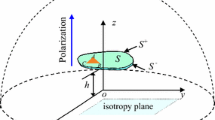Abstract
In this paper, the basic solution of a mode-I crack in functionally graded piezoelectric materials was investigated by using the generalized Almansi’s theorem. In the analysis, the electric permittivity of air inside the crack were considered. To make the analysis tractable, it was assumed that the shear modulus, piezoelectric constants and dielectric constants vary exponentially with coordinate parallel to the crack. The problem was formulated through Fourier transform into two pairs of dual integral equations, in which the unknown variables are jumps of displacements across the crack surfaces. To solve the dual integral equations, the jumps of displacements across the crack surfaces were directly expanded as a series of Jacobi polynomials. The solution of the present paper shows that the effects of the electric boundary conditions on the electric displacement fields near the crack tips can not be ignored. Simultaneously, the solution of the present paper will revert to a closed form one when the functionally graded parameter equals to zero.
Similar content being viewed by others
References
Zhu X, Zhu J, Zhou S, Li Q, Liu Z (1999) Microstructures of the monomorph piezoelectric ceramic actuators with functionally gradient. Sens Actuators A 74:198–202
Takagi K, Li JF, Yokoyama S, Watanabe R (2003) Fabrication and evaluation of PZT/Pt piezoelectric composites and functionally graded actuators. J Eur Ceram Soc 10:1577–1583
Chen J, Liu ZX, Zou ZZ (2003) Electriomechanical impact of a crack in a functionally graded piezoelectric medium. Theor Appl Fract Mech 39:47–60
Ueda S (2006) Transient response of a center crack in a functionally graded piezoelectric strip under electromechanical impact. Eng Fract Mech 73:1455–1471
Jin B, Zhong Z (2002) A moving mode-III crack in functionally graded piezoelectric material: permeable problem. Mech Res Commun 29:217–224
Wang BL (2003) A mode-III crack in functionally graded piezoelectric materials. Mech Res Commun 30:151–159
Li CY, Weng GJ (2002) Antiplane crack problem in functionally graded piezoelectric materials. J Appl Mech 69(4):481–488
Zhou ZG, Wang B (2004) Two parallel symmetry permeable cracks in functionally graded piezoelectric/piezomagnetic materials under anti-plane shear loading. Int J Solids Struct 41:4407–4422
Zhou ZG, Wu LZ, Wang B (2005) The behavior of a crack in functionally graded piezoelectric/piezomagnetic materials under anti-plane shear loading. Arch Appl Mech 74(8):526–535
Morse PM, Feshbach H (1958) Methods of theoretical physics, vol 1. McGraw-Hill, New York
Gao HJ, Zhang TY, Tong P (1997) Local and global energy release rates for an electrically yielded crack in a piezoelectric ceramics. J Mech Phys Solids 45(4):491–510
Zhang TY, Qian CF, Tong P (1998) Linear electro-elastic analysis of a cavity or a crack in a piezoelectric material. Int J Solids Struct 35:2121–2149
Zhong Z, Meguid SA (1997) Analysis of a circular arc-crack in piezoelectric materials. Int J Fract 84:143–158
Parton VS (1976) Fracture mechanics of piezoelectric materials. ACTA Astronaut 3:671–683
Mikhailov GK, Parton VS (1990) Electromagnetoelasticity. Hemisphere, New York
Pak YE (1990) Crack extension force in a piezoelectric material. J Appl Mech 57:647–653
Han JJ, Chen YH (1999) Multiple parallel cracks interaction problem in piezoelectric ceramics. Int J Solids Struct 36:3375–3390
Soh AK, Fang DN, Lee KL (2000) Analysis of a bi-piezoelectric ceramic layer with an interfacial crack subjected to anti-plane shear and in-plane electric loading. Eur J Mech A/Solid 19:961–977
Hao TH, Shen ZY (1994) A new electric boundary condition of electric fracture mechanics and its applications. Eng Fract Mech 47(6):793–802
Hao TH (2001) Multiple collinear cracks in a piezoelectric material. Int J Solids Struct 38(50–51):9201–9208
Yang FQ (2001) Fracture mechanics for a Mode I crack in piezoelectric materials. Int J Solids Struct 38:3813–3830
Gradshteyn IS, Ryzhik IM (1980) Table of integrals, series and products. Academic Press, New York
Erdelyi A (ed) (1954) Tables of integral transforms, vol 1. McGraw-Hill, New York
Zhou ZG, Wang B, Yang LJ (2004) Investigation of the behavior of an interface crack between two half-planes of orthotropic functionally graded materials by using a new method. JSME Int J 47(3):467–478
Itou S (1978) Three dimensional waves propagation in a cracked elastic solid. J Appl Mech 45(5):807–811
Zhou ZG, Wu LZ, Wang B (2006) The scattering of harmonic elastic anti-plane shear waves by two collinear cracks in anisotropic material plane by using the non-local theory. Meccanica 41(6):591–598
Zhou ZG, Wang B (2006) Investigation of the behavior of an interface crack for a functionally graded strip sandwiched between two homogeneous layers of finite thickness by use of the Schmidt method for the opening mode. Meccanica 41(2):79–99
Shbeeb NI, Binienda WK (1999) Analysis of an interface crack for a functionally graded strip sandwiched between two homogeneous layers of finite thickness. Eng Fract Mech 64:693–720
Author information
Authors and Affiliations
Corresponding author
Rights and permissions
About this article
Cite this article
Zhou, ZG., Hui, JF. & Wu, LZ. Basic solution of a mode-I limited-permeable crack in functionally graded piezoelectric materials. Meccanica 43, 21–35 (2008). https://doi.org/10.1007/s11012-007-9091-5
Received:
Accepted:
Published:
Issue Date:
DOI: https://doi.org/10.1007/s11012-007-9091-5



